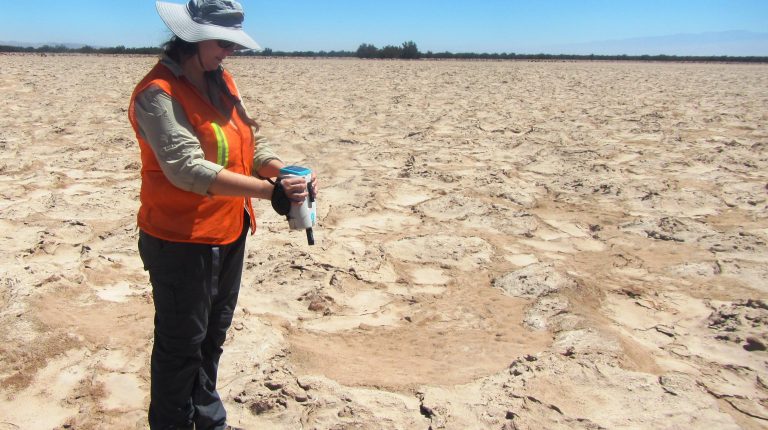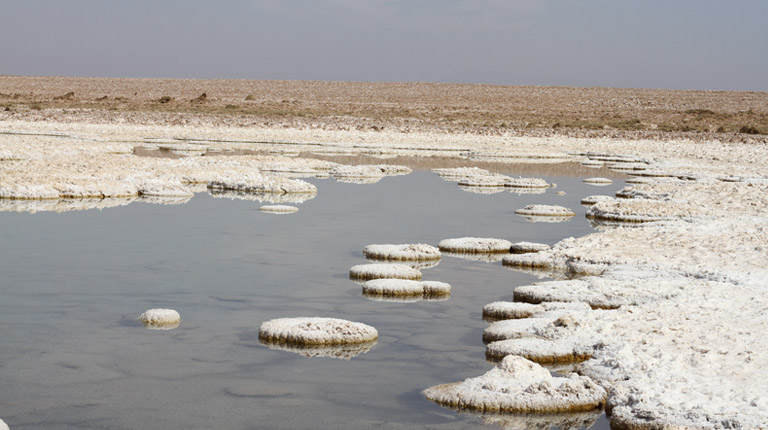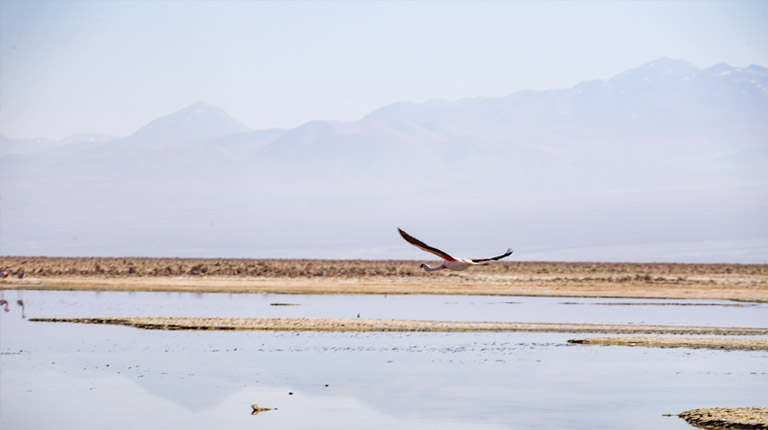Environmental Monitoring Plan
At SQM we carry out our operations conscientiously, in harmony with the environment and in compliance with environmental legislation in effect. It is essential that we work to ensure that natural resources and production inputs are used sustainably and to minimize the possible impacts of our production processes on the environment and neighboring communities. We conduct our activities in accordance with our Sustainable Development Policy in order to minimize environmental impact and incorporate environmental variables into our operations early on, beginning in the design stage. This helps us to implement control and mitigation measures and avoid contamination by properly managing waste and emissions.

ENVIRONMENTAL MONITORING PLAN - SALAR DE LLAMARA
 At SQM we carry out our operations conscientiously, in harmony with the environment and in compliance with environmental legislation in effect. It is essential that we work to ensure that natural resources and production inputs are used sustainably and to minimize the possible impacts of our production processes on the environment and neighboring communities. We conduct our activities in accordance with our Sustainable Development Policy in order to minimize environmental impact and incorporate environmental variables into our operations early on, beginning in the design stage. This helps us to implement control and mitigation measures and avoid contamination by properly managing waste and emissions.
At SQM we carry out our operations conscientiously, in harmony with the environment and in compliance with environmental legislation in effect. It is essential that we work to ensure that natural resources and production inputs are used sustainably and to minimize the possible impacts of our production processes on the environment and neighboring communities. We conduct our activities in accordance with our Sustainable Development Policy in order to minimize environmental impact and incorporate environmental variables into our operations early on, beginning in the design stage. This helps us to implement control and mitigation measures and avoid contamination by properly managing waste and emissions.
MONITORING TAMARUGO TREES AND VEGETATION IN LLAMARA
The Company monitors tamarugo tree vitality each year in November, when vegetation is most abundant. This monitoring is conducted using high-resolution satellite images (Quickbird, WorldView 2, WorldView 3 or Geoeye). A series of physiological measurements of tamarugo tres are also taken periodically. These measurements are determining factors in analyzing the hydric status of tamarugos. Experts also monitor retama thickets and hydromorphic meadows in the area around the lagoons known as Puquios de Llamara in order to evaluate the status of these plants. Measurements include the percentage of green growth, vigor and phenology.MONITORING AQUATIC BIOTA AND SURFACE WATER INLLAMARA
We also conduct semi-annual monitoring of aquatic biota and surface water in Puquios de Llamara in order to verify that there are no unforeseen effects. The variables controlled by monitoring of aquatic biota include: Composition of phytoplankton and phytobentos, Diversity of zooplankton and bentos, and Development and status of macrophytes.MITIGATION MEASURES FOR HYDRIC SYSTEM IN PUQUIOS DE LLAMARA
A mitigation measure has been implemented to reduce the effects of the decline in the wáter table on the Llamara aquifer as a result of pumping taking place approximately 8 km north of this site. By returning water to the ground, water levels and chemical quality are maintained within normal ranges for adequate development of biotic systems. In addition, in 2019 SQM commissioned an important number of studies on the “puquios” and their biotic systems, which were conducted by teams of professionals from leading Chilean and international organizations and institutions.HYDROGEOLOGICAL ENVIRONMENTAL MONITORING PLAN
This monitoring involves monthly measurements of aquifer levels, chemical quality, water volumes and flows extracted from wells, which enables the Company to verify predicted impacts during project operation and, if necessary, activate its Early Warning Plan.TAMARUGO ENVIRONMENTAL MANAGEMENT PLAN
In 2019 we continued activities as part of the Tamarugo Environmental Management Plan that was launched four years ago with the tamarugo tree planting program in the district of Pozo Almonte, in the Tarapacá Region. This program involved planting 5,522 tamarugos in the Bellavista Sector and 247 in the Llamara Sector for a total of 5,769 trees of this endemic species. Throughout the reporting period, these tres continued to be monitored, supervised and watered, which has yielded a good level of vitality despite the difficulties faced by this species in its early stages of development. The Company is studying the possibility of planting an additional 1,000 tamarugo tres in 2020 as part of this program. All data and knowledge generated through these activities and complementary studies are used in the environmental education program carried out in conjunction with the National Forestry Corporation (CONAF) in the Pampa del Tamarugal National Reserve.Environmental Monitoring Plan - Salar De Atacama
 In the Environmental Impact Study for the project “Changes and Improvements to Mining Operations at Salar de Atacama”), one of the commitments made in the Environmental Qualification Resolution was to implement an Environmental Monitoring Plan to evaluate the status of the systems in the Salar de Atacama over time. The monitoring plan entails: • Measuring the levels and physical and chemical qualities of water distributed among shallow and deep wells, metric rods at lagoon level and gauging stations. • Measuring meteorological variables at meteorological stations known as “Chaxa” and “KCl.” Our operations are located near ecosystems that are highly valuable in certain sectors. We have implemented an Environmental Biotic Monitoring Plan to closely monitor key variables for determining the status of the vegetation, flora, fauna and aquatic life in the ecosystems under protection. This monitoring controls a set of variables using direct, onsite measurements and highresolution satellite images (QuickBird or WorldView 2). The variables observed as part of this biotic monitoring in the Salar de Atacama include: • Vegetation with 99 monitoring points along the eastern Edge of the Salar de Atacama. • 75 plots recording flora, distributed in 7 transects along the eastern edge of the Salar de Atacama • 18 fauna monitoring stations (birds, mammals, reptiles) • 18 soil moisture and characterization sampling points • 25 aquatic life sampling stations (Soncor, Aguas de Quelana and Peine lake systems) • Flamingo Census with CONAF • Monitoring of flamingo breeding Cycle
In the Environmental Impact Study for the project “Changes and Improvements to Mining Operations at Salar de Atacama”), one of the commitments made in the Environmental Qualification Resolution was to implement an Environmental Monitoring Plan to evaluate the status of the systems in the Salar de Atacama over time. The monitoring plan entails: • Measuring the levels and physical and chemical qualities of water distributed among shallow and deep wells, metric rods at lagoon level and gauging stations. • Measuring meteorological variables at meteorological stations known as “Chaxa” and “KCl.” Our operations are located near ecosystems that are highly valuable in certain sectors. We have implemented an Environmental Biotic Monitoring Plan to closely monitor key variables for determining the status of the vegetation, flora, fauna and aquatic life in the ecosystems under protection. This monitoring controls a set of variables using direct, onsite measurements and highresolution satellite images (QuickBird or WorldView 2). The variables observed as part of this biotic monitoring in the Salar de Atacama include: • Vegetation with 99 monitoring points along the eastern Edge of the Salar de Atacama. • 75 plots recording flora, distributed in 7 transects along the eastern edge of the Salar de Atacama • 18 fauna monitoring stations (birds, mammals, reptiles) • 18 soil moisture and characterization sampling points • 25 aquatic life sampling stations (Soncor, Aguas de Quelana and Peine lake systems) • Flamingo Census with CONAF • Monitoring of flamingo breeding Cycle